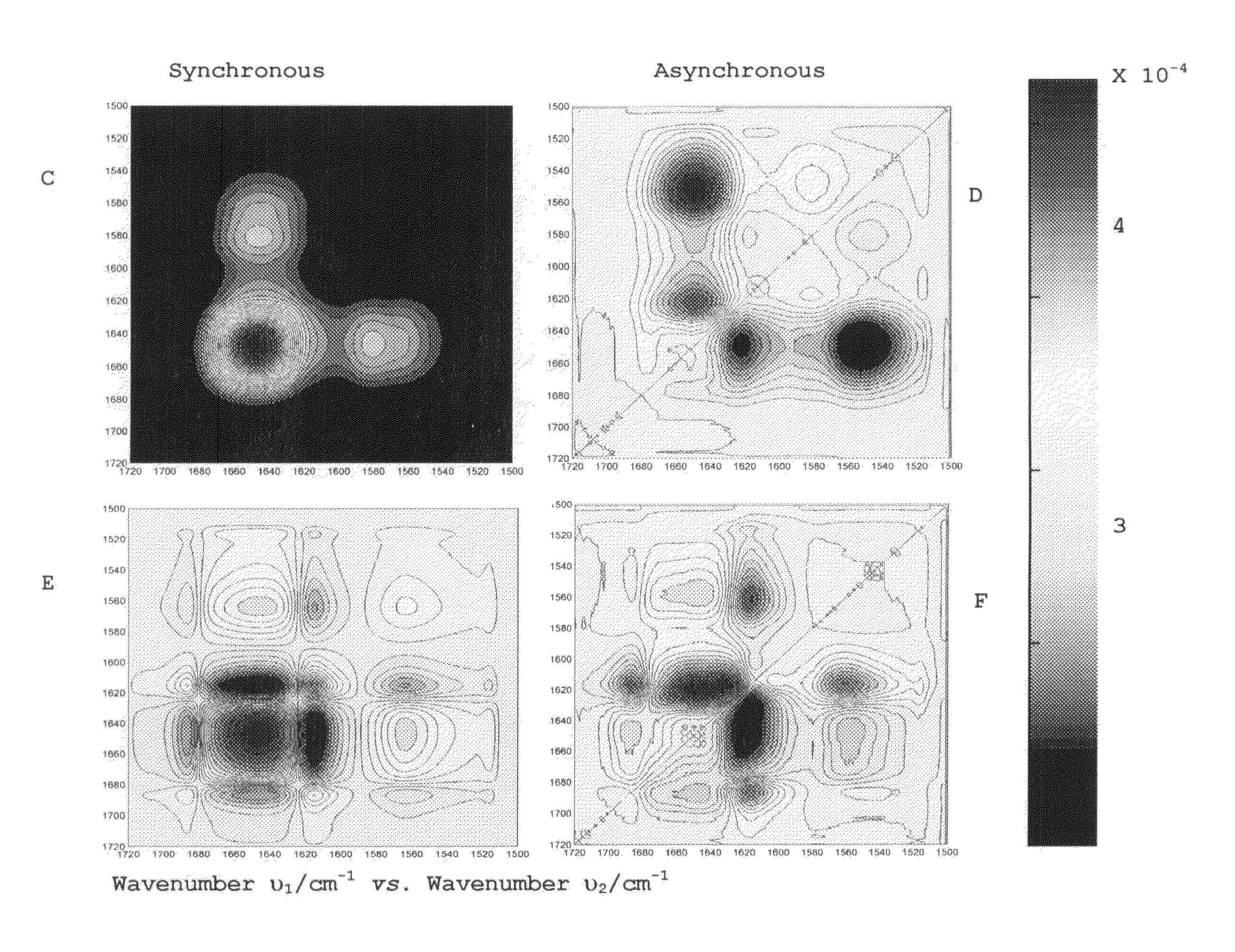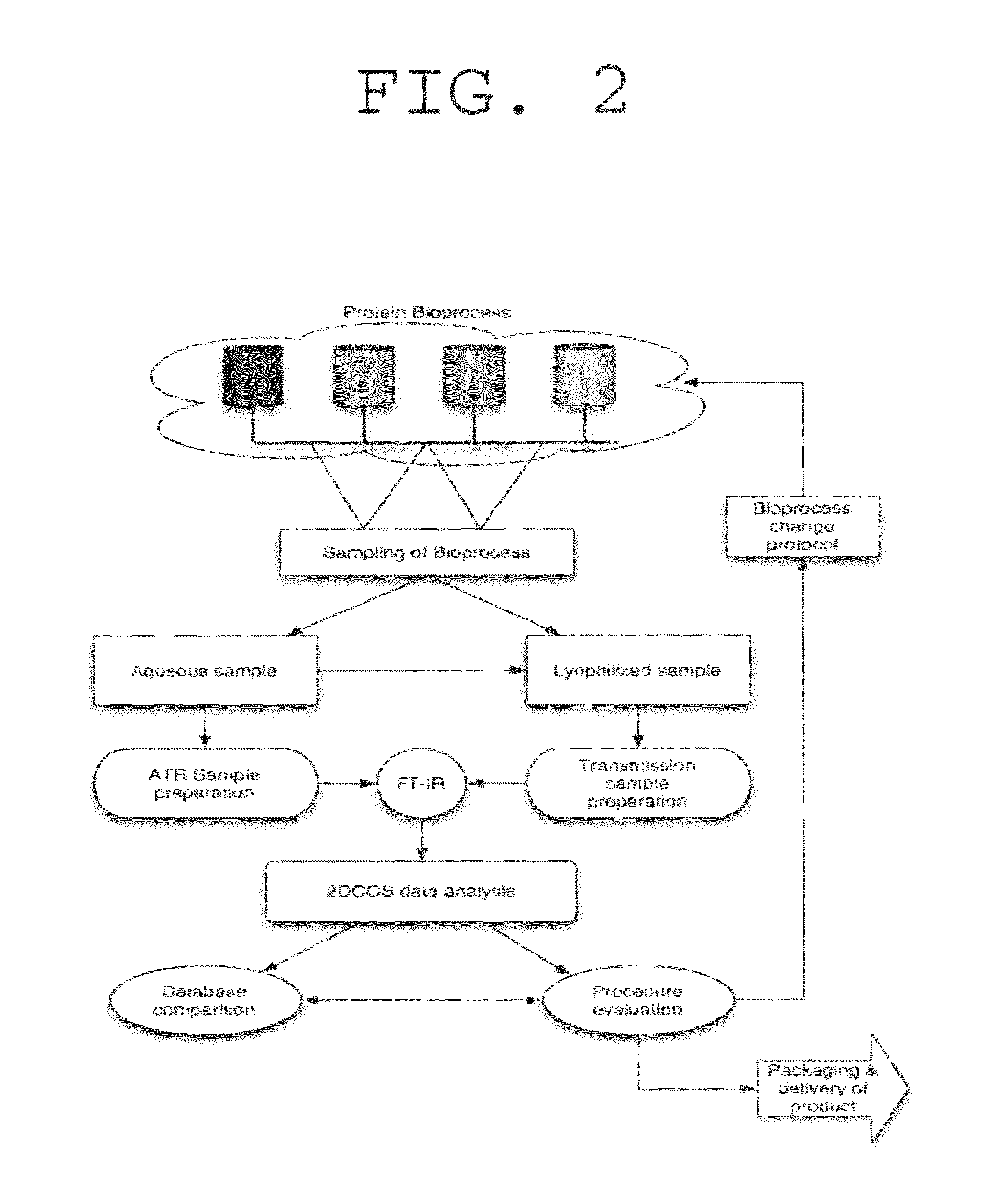Method for determination of protein, peptide or peptoid aggregation, stability, and viability and system using the same
- Summary
- Abstract
- Description
- Claims
- Application Information
AI Technical Summary
Benefits of technology
Problems solved by technology
Method used
Image
Examples
example 1
Epidermal Growth Factor (EGF)
[0043]The first example chosen is a human recombinant mitogenic polypeptide, known as epidermal growth factor (EGF) comprised of amino acids and three disulfide bridges. Its secondary structure is highly conserved primarily beta sheet, turns and random coil. The cellular pathways associated to the binding of these growth-factor polypeptides to growth factor receptors lead to cell proliferation and act in an atypical manner in tumor cells.
[0044]Results of the thermal dependence studies for EGF within the spectral region of 1720-1500 cm−1 are shown in FIG. 3. The decrease in intensity of the amide I band along with a shift to lower wavenumbers from 1645 to 1638 cm−1 and the appearance of a shoulder at 1620 cm−1 is indicative of thermal denaturation and aggregation, decrease of the amide II band associated with side chain modes. Therefore the method serves to determine the melting temperature (Tm) of the polypeptide as well. A plot of the FWHH of the amide ...
example 2
Methionine Adenosyltransferase (MAT)
[0046]In the thermal denaturation of the MAT (Methionine adenosyltransferase) protein (1,584 amino acids in its homotetramer form, for a molecular weight of 198 kDa), apparently a cooperative two-state denaturation process is assumed, as seen at the 3D plot of the deconvolved spectra for MAT in FIG. 7. Further studies using 2DCOS show that it's not a fully two state process, with a more complex denaturation pattern. The aggregation is characterized by the appearance of two bands at 1620 cm−1 and 1680 cm−1.
[0047]In the temperature range of 37-53° C., the activity of the protein is being gradually lost. 2DCOS plots as shown in FIG. 8 have been used to show that aggregation has occurred at the expense of the α-helix and β-sheet structural motifs and also of the residual β-turns. The synchronous plot has autopeaks at 1652 cm−1 and 1635 cm−1, with a positive cross-peak between them, showing that both structures (α-helix and β-turn, respectively) are de...
example 3
[0048]Insulin is an α-helical peptide with a total of 51 amino acids (about 6.5 kDa). Heating this peptide up to 70° C. produces amyloid fibers, formed by β-sheet structure. FT-IR spectroscopy can be used to study this process as the appearance of a large band at 1620 cm−1 as shown in FIG. 9, associated to fiber formation. Thus, this method is comparably easy when compare to other methods, which require preparing several samples, the use of external probes and does not analyze the secondary structure, so the mechanism of the aggregation can't be studied.
[0049]FIG. 10 shows the asynchronous and synchronous plots summarizing the events related to fiber formation. An autopeak at 1620 cm−1 on the Synchronous plot is associated to the fiber formation with the concomitant loss of the α-helix native structure (1650 cm1). The asynchronous plot shows this process involving a new structure at 1670 cm−1 (β-turns).
PUM
 Login to View More
Login to View More Abstract
Description
Claims
Application Information
 Login to View More
Login to View More - R&D
- Intellectual Property
- Life Sciences
- Materials
- Tech Scout
- Unparalleled Data Quality
- Higher Quality Content
- 60% Fewer Hallucinations
Browse by: Latest US Patents, China's latest patents, Technical Efficacy Thesaurus, Application Domain, Technology Topic, Popular Technical Reports.
© 2025 PatSnap. All rights reserved.Legal|Privacy policy|Modern Slavery Act Transparency Statement|Sitemap|About US| Contact US: help@patsnap.com



